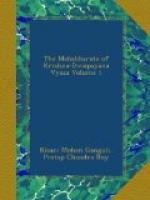My first question to him was,—whence was
the money to come, supposing my competence for the
task. Pratapa then unfolded to me the details
of his plan, the hopes he could legitimately cherish
of assistance from different quarters. He was
full of enthusiasm. He showed me Dr. Rost’s
letter, which, he said, had suggested to him the undertaking.
I had known Babu Durga Charan for many years and I
had the highest opinion of his scholarship and practical
good sense. When he warmly took Pratapa’s
side for convincing me of the practicability of the
scheme, I listened to him patiently. The two were
for completing all arrangements with me the very day.
To this I did not agree. I took a week’s
time to consider. I consulted some of my literary
friends, foremost among whom was the late lamented
Dr. Sambhu C. Mookherjee. The latter, I found,
had been waited upon by Pratapa. Dr. Mookherjee
spoke to me of Pratapa as a man of indomitable energy
and perseverance. The result of my conference
with Dr. Mookherjee was that I wrote to Pratapa asking
him to see me again. In this second interview
estimates were drawn up, and everything was arranged
as far as my portion of the work was concerned.
My friend left with me a specimen of translation which
he had received from Professor Max Muller. This
I began to study, carefully comparing it sentence
by sentence with the original. About its literal
character there could be no doubt, but it had no flow
and, therefore, could not be perused with pleasure
by the general reader. The translation had been
executed thirty years ago by a young German friend
of the great Pundit. I had to touch up every
sentence. This I did without at all impairing
faithfulness to the original. My first ‘copy’
was set up in type and a dozen sheets were struck
off. These were submitted to the judgment of
a number of eminent writers, European and native.
All of them, I was glad to see, approved of the specimen,
and then the task of translating the Mahabharata into
English seriously began.
Before, however, the first fasciculus could be issued,
the question as to whether the authorship of the translation
should be publicly owned, arose. Babu Pratapa
Chandra Roy was against anonymity. I was for it.
The reasons I adduced were chiefly founded upon the
impossibility of one person translating the whole
of the gigantic work. Notwithstanding my resolve
to discharge to the fullest extent the duty that I
took up, I might not live to carry it out. It
would take many years before the end could be reached.
Other circumstances than death might arise in consequence
of which my connection with the work might cease.
It could not be desirable to issue successive fasciculus
with the names of a succession of translators appearing
on the title pages. These and other considerations
convinced my friend that, after all, my view was correct.
It was, accordingly, resolved to withhold the name
of the translator. As a compromise, however,
between the two views, it was resolved to issue the
first fasciculus with two prefaces, one over the signature
of the publisher and the other headed—’Translator’s
Preface.’ This, it was supposed, would
effectually guard against misconceptions of every kind.
No careful reader would then confound the publisher
with the author.




